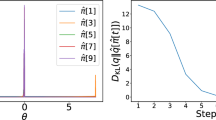Abstract
Imagine that measurements are made at times t 0 and t 1 of the trajectory of a physical system whose governing laws are given approximately by a class \({{\mathcal A}}\) of so-called prior vector fields. Because the physical laws are not known precisely, the measurements might not be realised by the integral curve of any prior field. We want to estimate the behaviour of the physical system between times t 0 and t 1. This is done by solving a variational problem, yielding so-called conditional extrema which satisfy an Euler–Lagrange equation. Then conservative prior fields on simply-connected Riemannian manifolds are characterised in terms of their conditional extrema. For specific prior fields on space forms, conditional extrema are obtained in terms of the Weierstrass elliptic function. Another class of examples comes from left-invariant prior fields on bi-invariant Lie groups, whose conditional extrema are shown to be right translations of pointwise-products of 1-parameter subgroups.
Similar content being viewed by others
References
Bullo F, Lewis AD (2005) Geometric control of mechanical systems. Texts in applied mathematics, vol 49. Springer, Berlin
Bullo F, Lewis AD (2005) Geometric control of mechanical systems. Euron/Geoplex Summer School on Modelling and Control of Complex Dynamical Systems (July 18–22). http://www-lar.deis.unibo.it/euron-geoplex-sumsch/files/lectures_2/slides-bullo.pdf
Chu Y, Huang Z, Hahn J (2009) Improving prediction capabilities of complex dynamical models via parameter selection and estimation. Chem Eng Sci 64(19): 4178–4185
de Boor C (2001) A practical guide to splines. Applied Mathematical Sciences, vol 27. Springer, Berlin
Holm DD, Schmah T, Stoica C (2009) Geometric mechanics and symmetry Oxford texts in applied and engineering mathematics, vol 12. Oxford University Press, Oxford
Marsden JE (1974) Elementary classical analysis. W.H. Freeman and Co, New York
Milnor J (1963) Morse Theory. Annals of Mathematics Studies, vol 51. Princeton University Press, Princeton
Nelles O (2001) Nonlinear system identification. Springer, Berlin
Ratcliffe JG (1994) Foundations of hyperbolic manifolds. Graduate texts in mathematics, vol 149. Springer, New York
Toni T, Welch D, Strelkowa N, Ipsen A, Stumpf MPH (2009) Approximate Bayesian computation scheme for parameter inference and model selection in dynamical systems. J R Soc Interface 6: 187–202
Tuynman GM (1995) The derivation of the exponential map of matrices. Am Math Mon 102(9): 818–820
Varadarajan VS (1984) Lie groups, lie algebras and their representations. Springer, New York
Author information
Authors and Affiliations
Corresponding author
Rights and permissions
About this article
Cite this article
Noakes, L. Conditional extremals. Math. Control Signals Syst. 24, 295–320 (2012). https://doi.org/10.1007/s00498-012-0081-3
Received:
Accepted:
Published:
Issue Date:
DOI: https://doi.org/10.1007/s00498-012-0081-3



